When I was younger, I lived in a few shared apartments. Although my roommates weren’t super loud, I was always amazed by the level of noise that would seep into my room through the door.
Since learning more about the principles of sound transmission and soundproofing projects, I’ve dedicated a lot of time to figuring out how to reduce noise coming through doors as much as possible. After all, they’re one of the weakest areas of a room’s setup.
And this is exactly what I discuss below. In this article, we’ll look at the best interior doors for soundproofing. Before jumping into some technical comparisons, let’s understand the metrics we’ll use.
Soundproofing Basics
We’ll cover some of the basic principles of sound transmission and the most suitable metrics before we start looking at different types of doors. We’ll use this information throughout the article to compare structures and materials.
How to Measure Sound Transmission Using STC
Did you know that noise is subjective? This might seem like an odd thing to say, but something I find too loud could be perfectly fine for you. There are numerous reasons for this, including our hearing ability, familiarity with loud noises, and more.
As such, we need an objective metric so that we can compare sound transmission loss. This is where STC comes in.
STC stands for sound transmission class. In short, is a measurement of how much sound a material attenuates (blocks). We typically use it for building materials, such as drywall, brick, concrete, glass, etc.
STC values are calculated using lab tests. It’s not super relevant to cover what these tests involve, but it’s enough to know that they’re verified measurements that we can use with confidence.
We express STC ratings as full numbers – the higher the number, the better a material attenuates sound. Some example ratings are:
| STC | What can you hear? |
|---|---|
| 25 | Soft speech can be heard and understood |
| 30 | Normal speech can be heard and understood |
| 35 | Loud speech can be heard and understood |
| 40 | Loud speech can be heard but you can’t understand it |
| 45 | The minimum threshold for privacy |
| 50 | Loud sounds can be heard faintly |
| 60 and above | The base level for good soundproofing |
As you can see, the rating we should aim for is 45, although 50 is a good minimum to aim for.
Why Doors Matter for Soundproofing
Using a few standard building materials, we can achieve a fairly high STC rating for an interior wall. For example, 2 layers of drywall with studs and fiberglass insulation has an STC of 39. While this still means loud sounds can be heard, it’s a fairly good rating for what are frankly quite thin materials.
In my experience, a drywall and fiberglass setup is pretty standard for interior partition walls. As such, it’s the example we’ll use in this article for comparing interior doors.
Unlike an interior wall, interior doors typically have very poor STC ratings. They’re usually hollow, and doors are also much thinner than walls. Then we have the air gaps between the door and its frame, along with other points of potential weakness.
In short, doors are the weak point in a wall, so finding the best interior doors in terms of soundproofing matters a lot.
The Best Types of Doors for Soundproofing
There’s quite a range of different interior soundproof doors that we can pick from. The best way for me to display this information is by listing the doors from worst to best performance, giving a brief description of their construction, along with a typical STC rating.
Hollow Core Door – STC 19
This is probably the most common type of interior door. A standard hollow core door consists of 2 external sheets of thin wood with nothing in the middle. As such, its STC rating is very poor.
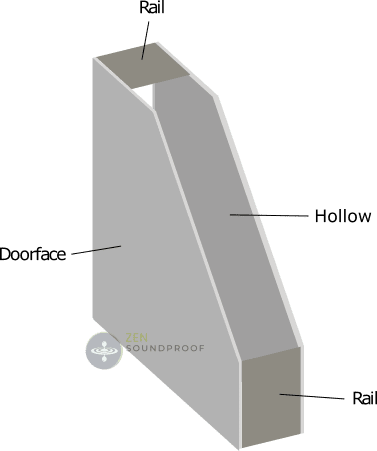
Solid Core Wood Door – STC 26
A fairly self-explanatory name. Solid core doors are made from a solid piece of wood, perhaps with external decorative layers. The extra mass in solid wood doors means its sound attenuation properties are marginally better than a hollow core door, and also means they’re more common as exterior doors.
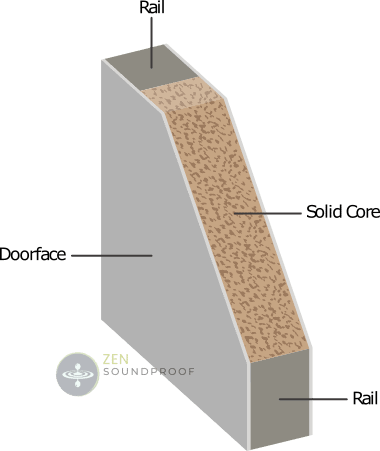
Metal Door with Insulated Core – STC 26
A lot of metal doors will have a plastic or resin core, which could be urethane, polyurethane, fiberglass or similar material. While this isn’t mass rich, it does provide some sound absorption properties.
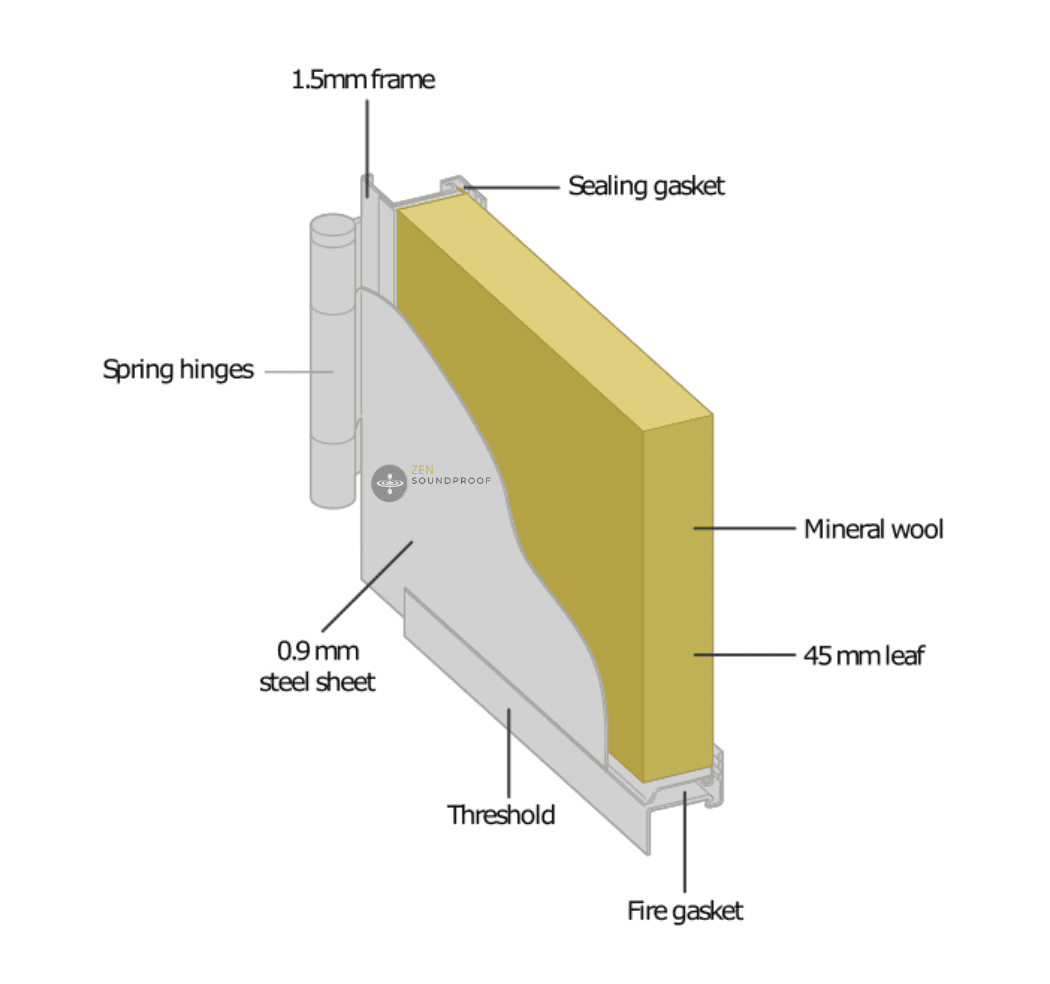
Glass Door – 26-32
A glass door can be anything from a single pane to a dual pane with an air gap. Insulated (laminated) glass and air space can push the STC rating to the top end possible for glass doors.
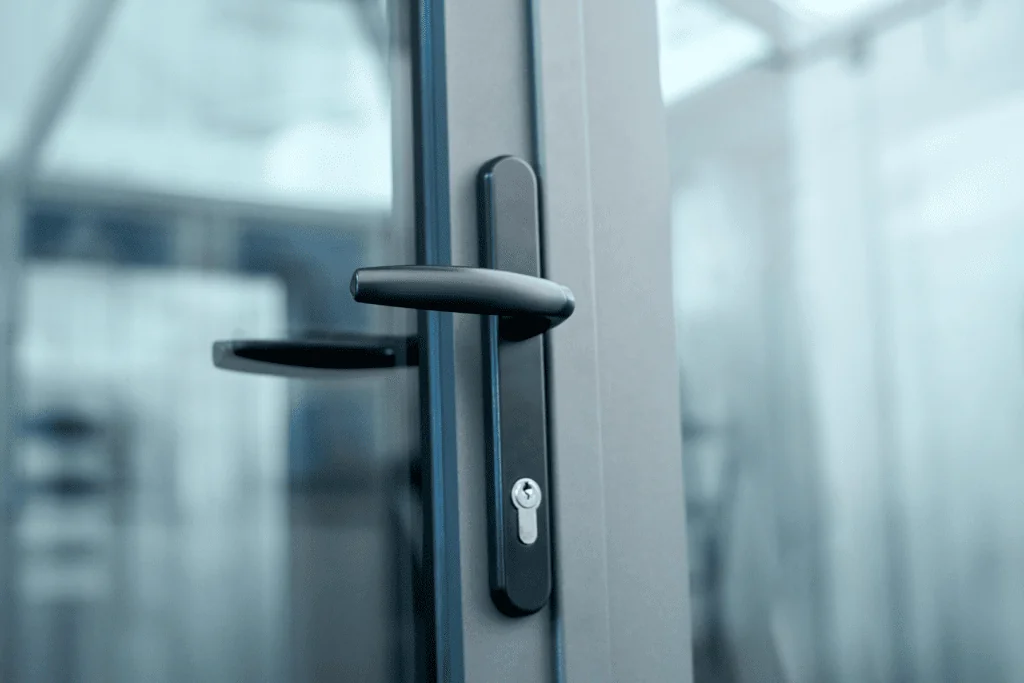
Honeycomb Door – STC 35
A honeycomb door typically consists of 2 exterior panels with a honeycomb interior. This can be made of wood, plastic or metal, and provides the door with stability and rigidity. However, it has a surprising effect on a door’s STC rating.
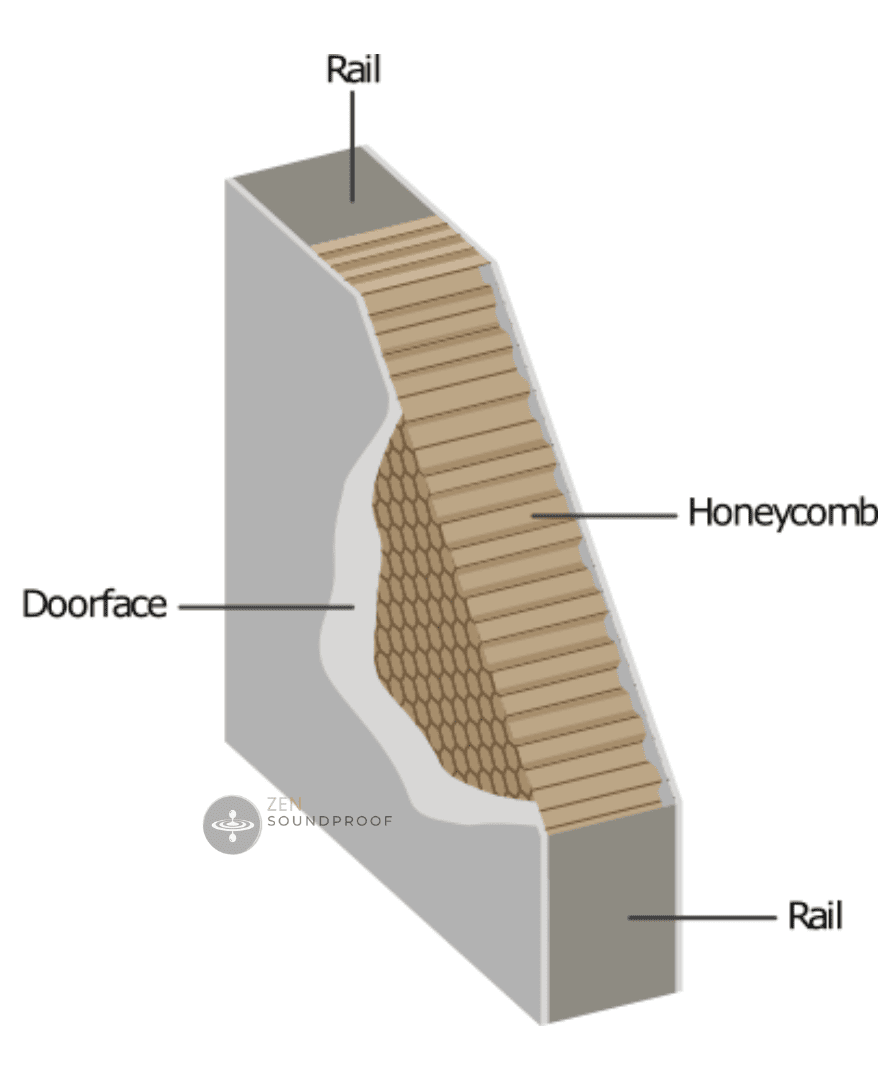
Metal Door with steel stiffeners – STC 35-43
Metal is a more mass rich material than wood, so it shouldn’t come as a surprise that a solid metal door would have a noticeably higher STC rating than a solid wood door.
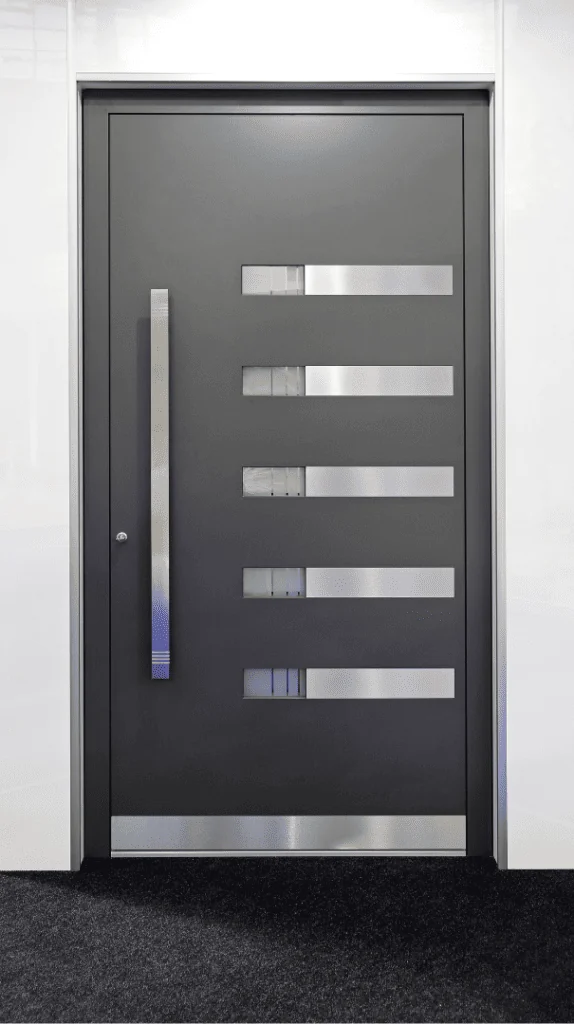
The key here, though, is adding the stiffeners. Making the material more rigid means the resonant frequencies are far higher, potentially moving them out of the low-medium-frequency range that we’re concerned with.
Acoustic Door – STC 45 and above
There are quite a few factors that can influence an acoustic door, such as interior material, exterior material thickness, surrounding construction, etc. As such, the STC value can vary massively. Steelcraft states you can reach 45 STC, whereas IA Acoustics states its doors can range from 51-64.
What is the Best Door for Soundproofing?
Objectively, the best door for soundproofing is a customized acoustic door. However, these aren’t always practical because they include frames, insulation, and other factors to achieve high STC ratings.
Instead, the best interior door for standard applications would be a honeycomb door or a laminated or solid core door. These are more cost-effective and provide a drastic improvement over normal hollow core doors.
Based on our knowledge of STC ratings, for a normal room, I’d recommend aiming for a honeycomb door or a steel stiffened metal door. These have ratings most similar to a standard interior wall, meaning you won’t lose anything in terms of noise reduction.
Of course, if you’re soundproofing your walls too, you’ll want to pick a door that matches your new setup. If it’s considerably better than a normal partition wall, an acoustic door might be the way forwards.
The Worst Doors for Soundproofing
I’ve mentioned hollow core doors at the bottom of the list above, but it might surprise you to learn you can have even worse doors when it comes to soundproofing! Some examples include:
If you’re familiar with these door types, you’ll likely know why this is the case. Pocket and barn doors have large gaps around them due to the way they sit on (or in) the wall. Similarly, French doors have issues with glass thickness, frame material, insulation, and door fittings.
Factors to Consider
I’ve already touched upon some of the important factors when choosing a soundproof door. However, I feel it’s relevant to cover them explicitly. This’ll help you make an informed decision if you don’t have STC ratings to refer to.
So, here’s what matters when choosing a decent soundproof door.
Mass
Mass is a vital metric in soundproofing – it’s what we rely on when choosing many construction materials. It translates to a material’s ability to block sound waves from passing through. In short, the more mass a material has, the harder it is to vibrate (sound waves are vibrational energy).
Normal interior doors aren’t rich in mass, especially hollow core doors. This is why their STC ratings are typically so low.
If it’s not possible for you to find solid doors or other mass-rich options, there are 2 solutions you can try.
The first is to stack up heavy layers around the door’s core to increase its mass. A good material for this is mass loaded vinyl, as it’s fairly thin for the amount of mass it provides.
Another option to try is to set up a communicating door, such as those you’d see in hotels. The image below shows what this would look like. According to Steelcraft, 2 solid core wood doors could have an STC rating of 33. To me, an STC of 33 is ideal if you only aim at blocking normal speech, but insufficient against loud voices.

Insulation
Insulation in soundproofing typically provides absorption. In short, this traps sound waves and causes them to expend their energy.
While absorption isn’t typically used to reduce sound transmission, it’ll help to an extent by decreasing the level of vibrational energy sound waves possess. When combined with other materials, this can reduce sound transmission.
Insulation materials within the door can be fiberglass, polystyrene, or urethane. Anything you’d find in an interior wall could also go in an insulated door.
Stiffener
The honeycomb structure within some doors is designed to stiffen the door. It’s particularly helpful for steel doors, which could otherwise be a bit bendy considering the size of the sheet of metal you’d be working with.
Data from Steelcraft shows that honeycomb doors perform noticeably better than those with a polystyrene core. For example, the same door with a honeycomb interior has an STC of 35 rather than 25 for a polystyrene core. The steel stiffened door performs better still, going as high as 43 STC.
| Door Type | STC |
|---|---|
| Polystyrene door | 25 |
| Honeycomb door | 35 |
| Steel stiffened | 43 |
The logic behind this is that the honeycomb stiffens the door. While there’s a point at which rigid materials aren’t good for soundproofing, a certain level of rigidity will help reduce a sound wave’s ability to pass through a structure because it has higher resonant frequencies.
Sealing Out Noise
Choosing the right door is one thing, but it’s almost pointless if you don’t also work on the frame and seal. In some ways, sound works a lot like heat energy, specifically that it can fit through small gaps and will try to find the path of least resistance. An example of this would be the gap between a door and the door frame.
So, along with installing a soundproof door, you’ll want to try and seal this gap to the best of your ability. There are several products you could try to soundproof a door.
Weatherstripping
Weatherstripping is designed to provide thermal insulation, but it can help with acoustic insulation too. Although it’s typically not a thick or mass rich material, its benefit is that it can compress to effectively fill the gap around the door trim.
This is because most weatherstripping is made from rubber, foam or felt, all of which are resilient materials.
It’s also super easy to install, as most products are self-adhesive. You simply fit it around the inside of the door jamb where it meets the door, and it’ll help seal the gap and reduce noise transmission.
Automatic Door Seals
There are loads of types of door seals (also known as a door sweep) out there. An automatic door sweep is good for soundproofing, as it consists of a rigid material like metal or vinyl. Again, door sweeps might not be the most mass-rich, but they help block the air gap at the bottom of the door.
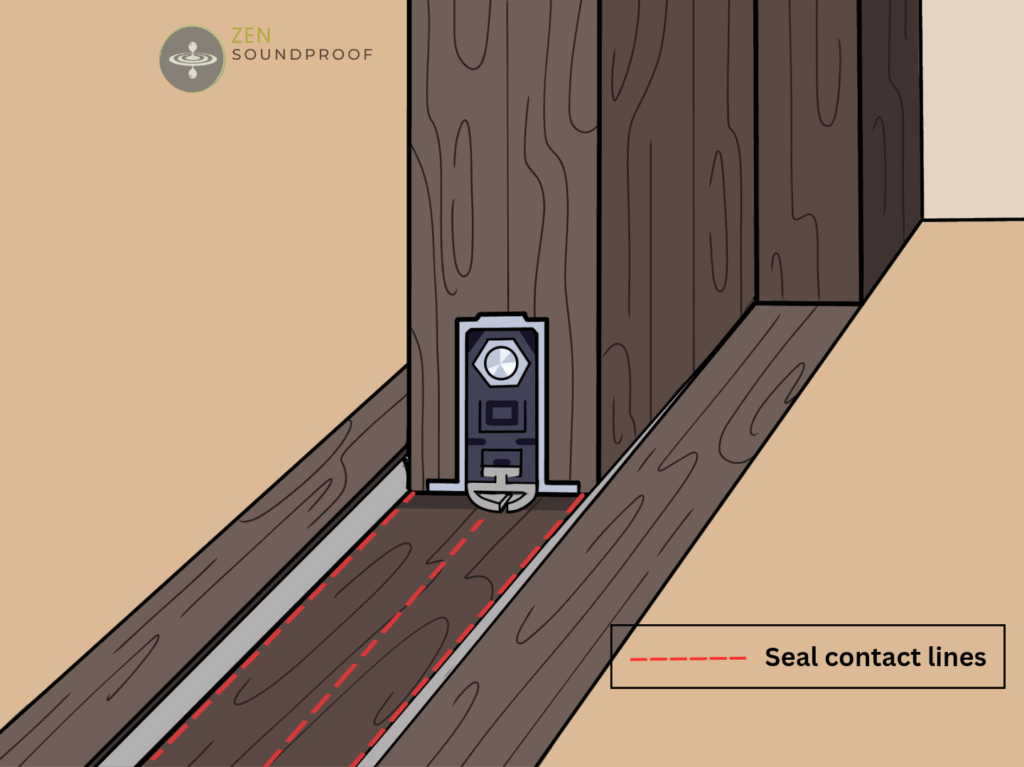
Some of the most effective gaskets drop into a channel below the door when it shuts. Drop-down gaskets of this kind can create a tighter seal than if the gasket were to just drop to the floor.
Final Thoughts
I hope this article has helped clarify what type of soundproof interior doors you should look for when it comes to reducing sound transmission.
The short answer is that acoustic doors perform the best. However, a good balance between price, availability and performance is a honeycomb door. Failing that, find the heaviest and densest door you can afford.
Do you have any other tips for choosing a decent soundproof interior door? If so, let me know your advice in the comments.
